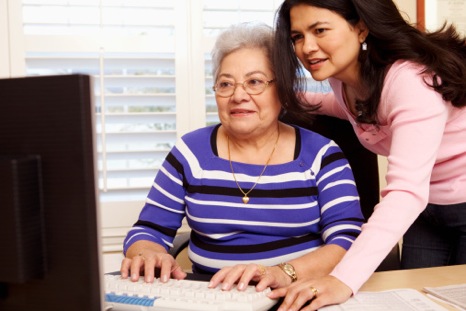With more and more of the elderly using technology, especially our aging Baby Boomers, assistive computer technology can go a long way in helping those whose abilities begin to wane. There are very useful options like automation, voice commands, and dictation, for those in need of assistive technology. These could make otherwise difficult tasks much easier. Accordingly, elderly assistive technology is a hot area of innovation.
Assistive Technology
Assistive technology is a category of devices that assists those with limited physical and sometimes cognitive abilities. In fact, it can even help them perform certain activities of daily living (ADLs). In particular, these often come into play for seeing and hearing. Below are some elderly assistive technology devices for an easier internet experience.
Apple
Apple has made several assistive technologies and customization options standard in its operating system – from the simple, like choosing higher-contrast color combinations to the more complex, like a sophisticated text-to-speech tool. Below are some of the tools available on Apple products that can aid the elderly who begin to experience visual, hearing and motor challenges.
-
VoiceOver is a screen reader or text-to-speech tool that comes standard with every Mac. This tool allows the user to fully interact with the computer, using gestures, a keyboard, or a Braille display as it reads what is on your screen.
-
Zoom is a built-in magnifier. It allows the user to enlarge the screen better by magnifying the display up to 20 times its original size.
-
Dictation, as the name suggests, lets users talk where they would normally type. Users can reply to email messages, search the internet, or even dictate in documents using just their voice.
-
Inverting Colors is a simple way to allow for better on-screen comprehension and recognition, because a higher contrast helps users better see what’s on the display. Once colors are determined, settings apply system-wide, allowing for a uniform experience in every app and program.
Microsoft
Microsoft products offer similar options in many of their products, through its Ease of Access Center. Furthermore, centrally located on Microsoft computers, this file allows users to set up the accessibility settings and programs available in Windows. Programs to assist in accessibility on Microsoft machines are similar to those of Apple:
- Speech Recognition
- Narrator
- High-contrast and customizable display settings
- Filter Keys which can steady a user’s hand by ignoring brief or repeated keystrokes made accidentally. An example is in the case of a tremulous or shaky hand. This could be extremely useful for those suffering from Parkinson’s disease.
Specifically, Microsoft also has a database of information and tutorials online, dedicated to operating systems such as Windows XP, and programs like Office and Internet Explorer, as well as PDF entitled, A Guide to Transitioning to Windows 7 for People with Disabilities.
During the course of time, as computers become increasingly easy to use, accessible technologies will continue to improve. Consequently, it will be easier for people of all abilities to communicate.
.
At David York Agency, we understand that caregiving is a process that demands compassion, caring, patience & expertise. Our office staff is up-to-date with the latest technology and caregiver techniques. We are ready and available whenever you decide to begin service. If you would like more information about home health aides, please contact us at 718.376.7755 or www.davidyorkagency.com and visit our Facebook, LinkedIn or Twitter pages.







